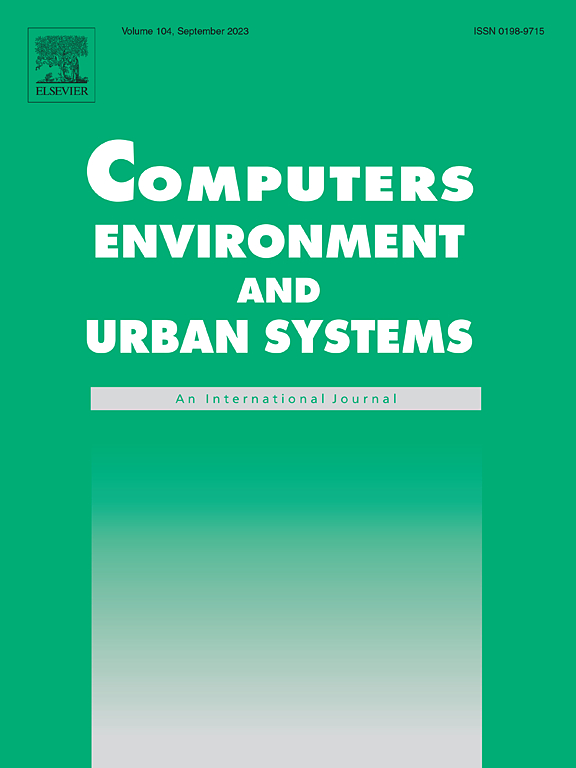从点到模式:城市功能布局的探索性POI网络研究
IF 8.3
1区 地球科学
Q1 ENVIRONMENTAL STUDIES
Computers Environment and Urban Systems
Pub Date : 2025-01-03
DOI:10.1016/j.compenvurbsys.2024.102246
引用次数: 0
摘要
在快速城市化的背景下,城市空间不仅容纳了不断增长的人口,还产生了复杂的社会经济活动和文化交流。城市是一个复杂的系统,传统的兴趣点(POI)分析方法通常评估不同社区兴趣点的密度和多样性,但往往无法捕捉到这种复杂性。为了解决这些问题,本研究引入了一种新的方法,即将POI序列转化为沿街道的单词,并应用潜在狄利克雷分配(Latent Dirichlet Allocation, LDA)模型来识别城市功能区。与依赖主观划定行政边界、Voronoi细胞或规则网格的传统方法不同,我们的方法确定了更贴近人类经验的街道功能区。基于这些功能主题,构建了多层次的POI - topic网络,以帮助更好地理解特定POI在城市功能区中的作用。这种方法有效地提炼了城市功能的空间分布模式,并为分析poi之间的相互关系提供了微观层面的基础,从而提供了对城市空间更细致入微的理解。通过伦敦的案例研究证明了该方法的有效性。结果表明,基于POI词汇的共现模式和网络结构,该方法可以有效地识别和圈定城市功能区。网络中心性分析进一步揭示了不同POI类型在城市空间功能组织中的作用和地位,揭示了其结构特征和相互作用模式。这种利用POI序列和网络分析的方法为城市规划者、地理空间科学家和政策制定者提供了一种新的工具,使他们能够更精确地理解和规划城市空间。本文章由计算机程序翻译,如有差异,请以英文原文为准。
From points to patterns: An explorative POI network study on urban functional distribution
In the context of rapid urbanization, urban spaces not only accommodate a growing population but also produces complex socio-economic activities and cultural exchanges. Cities are complex systems, and conventional Points of Interest (POI) analysis methods, which usually assess the density and diversity of POIs in various neighbourhoods, often fails to capture this complexity. To address these limitations, this study introduces a novel approach by transforming POI sequences into words along streets and applying Latent Dirichlet Allocation (LDA) model to identify urban functional regions. Unlike traditional approaches that rely on subjective delineation of administrative boundaries, Voronoi cells or regular grids, our approach identifies street level functional areas that align more closely with human experience. Based on these functional topics, a multi-layered Poi-Topic network is then constructed to help better understand the roles specific POI plays within urban functional regions. This approach effectively distills the spatial distributional patterns of urban functions and provides a micro-level foundations for analysing the contextual interrelationships between POIs, thereby offering a more nuanced understanding of urban spaces. The effectiveness of the approach is demonstrated through the London case study. The results show that the proposed approach can effectively identify and delineate urban functional areas based on the co-occurrence patterns and network structure of POI vocabularies. The network centrality analysis further reveals the structural properties and interaction patterns, providing valuable insights into the roles and positions of different POI types in the functional organization of urban space. This method of using POI sequences and network analysis offers a new tool for urban planners, geospatial scientists, and policymakers, enabling them to understand and plan urban spaces with greater precision.
求助全文
通过发布文献求助,成功后即可免费获取论文全文。
去求助
来源期刊

Computers Environment and Urban Systems
Multiple-
CiteScore
13.30
自引率
7.40%
发文量
111
审稿时长
32 days
期刊介绍:
Computers, Environment and Urban Systemsis an interdisciplinary journal publishing cutting-edge and innovative computer-based research on environmental and urban systems, that privileges the geospatial perspective. The journal welcomes original high quality scholarship of a theoretical, applied or technological nature, and provides a stimulating presentation of perspectives, research developments, overviews of important new technologies and uses of major computational, information-based, and visualization innovations. Applied and theoretical contributions demonstrate the scope of computer-based analysis fostering a better understanding of environmental and urban systems, their spatial scope and their dynamics.
 求助内容:
求助内容: 应助结果提醒方式:
应助结果提醒方式:


